High-Performance and Flexible Metamaterial Wave Absorbers with Specific Bandwidths for the Microwave Device
Abstract
:1. Introduction
2. Materials, Structure and Methods
3. Results and Discussion
4. Conclusions
Author Contributions
Funding
Institutional Review Board Statement
Informed Consent Statement
Data Availability Statement
Acknowledgments
Conflicts of Interest
References
- Veselago, V.G. The Electrodynamics of Substances with Simultaneously Negative Values of ε and μ. Phys.-Uspekhi 1968, 10, 509–514. [Google Scholar] [CrossRef]
- Pendry, J.B. Negative Refraction Makes a Perfect Lens. Phys. Rev. Lett. 2000, 85, 3966–3969. [Google Scholar] [CrossRef] [PubMed]
- Shelby, R.A.; Smith, D.R.; Schultz, S. Experimental Verification of a Negative Index of Refraction. Science 2001, 292, 77–79. [Google Scholar] [CrossRef] [Green Version]
- Silalahi, H.M.; Chiang, W.-F.; Shih, Y.-H.; Wei, W.-Y.; Su, J.-Y.; Huang, C.-Y. Folding Metamaterials with Extremely Strong Electromagnetic Resonance. Photon. Res. 2022, 10, 2215. [Google Scholar] [CrossRef]
- Salim, A.; Lim, S. Recent Advances in the Metamaterial-Inspired Biosensors. Biosens. Bioelectron. 2018, 117, 398–402. [Google Scholar] [CrossRef]
- Ginel-Moreno, P.; Sánchez-Postigo, A.; de-Oliva-Rubio, J.; Hadij-ElHouati, A.; Ye, W.N.; Wangüemert-Pérez, J.G.; Molina-Fernández, Í.; Schmid, J.H.; Cheben, P.; Ortega-Moñux, A. Millimeter-Long Metamaterial Surface-Emitting Antenna in the Silicon Photonics Platform. Opt. Lett. 2021, 46, 3733–3736. [Google Scholar] [CrossRef]
- Dong, Y.; Itoh, T. Metamaterial-Based Antennas. Proc. IEEE 2012, 100, 2271–2285. [Google Scholar] [CrossRef]
- Aydin, K.; Bulu, I.; Ozbay, E. Subwavelength Resolution with a Negative-Index Metamaterial Superlens. Appl. Phys. Lett. 2007, 90, 254102. [Google Scholar] [CrossRef] [Green Version]
- Zhao, F.; Li, Z.; Li, S.; Dai, X.; Zhou, Y.; Liao, X.; Cao, J.C.; Liang, G.; Shang, Z.; Zhang, Z.; et al. Terahertz Metalens of Hyper-Dispersion. Photon. Res. 2022, 10, 886. [Google Scholar] [CrossRef]
- Liu, Y.; Ouyang, C.; Xu, Q.; Su, X.; Yang, Q.; Ma, J.; Li, Y.; Tian, Z.; Gu, J.; Liu, L.; et al. Moiré-Driven Electromagnetic Responses and Magic Angles in a Sandwiched Hyperbolic Metasurface. Photon. Res. 2022, 10, 2056–2065. [Google Scholar] [CrossRef]
- Wu, C.; Khanikaev, A.B.; Shvets, G. Broadband Slow Light Metamaterial Based on a Double-Continuum Fano Resonance. Phys. Rev. Lett. 2011, 106, 107403. [Google Scholar] [CrossRef] [PubMed] [Green Version]
- Omam, Z.R.; Ghobadi, A.; Khalichi, B.; Ozbay, E. Fano Resonance in a Dolomite Phase-Change Multilayer Design for Dynamically Tunable Omnidirectional Monochromatic Thermal Emission. Opt. Lett. 2022, 47, 5781–5784. [Google Scholar] [CrossRef] [PubMed]
- Liu, S.; Xu, F.; Zhan, J.; Qiang, J.; Xie, Q.; Yang, L.; Deng, S.; Zhang, Y. Terahertz Liquid Crystal Programmable Metasurface Based on Resonance Switching. Opt. Lett. 2022, 47, 1891–1894. [Google Scholar] [CrossRef] [PubMed]
- Pan, Y.; Lan, F.; Zhang, Y.; Zeng, H.; Wang, L.; Song, T.; He, G.; Yang, Z. Dual-Band Multifunctional Coding Metasurface with a Mingled Anisotropic Aperture for Polarized Manipulation in Full Space. Photon. Res. 2022, 10, 416. [Google Scholar] [CrossRef]
- Silalahi, H.M.; Shih, Y.-H.; Lin, S.-H.; Chen, Y.-T.; Wei, W.-Y.; Chao, P.-L.; Huang, C.-Y. Electrically Controllable Terahertz Metamaterials with Large Tunabilities and Low Operating Electric Fields Using Electrowetting-on-Dielectric Cells. Opt. Lett. 2021, 46, 5962–5965. [Google Scholar] [CrossRef]
- Landy, N.I.; Sajuyigbe, S.; Mock, J.J.; Smith, D.R.; Padilla, W.J. Perfect Metamaterial Absorber. Phys. Rev. Lett. 2008, 100, 207402. [Google Scholar] [CrossRef]
- Maier, T.; Brückl, H. Wavelength-Tunable Microbolometers with Metamaterial Absorbers. Opt. Lett. 2009, 34, 3012–3014. [Google Scholar] [CrossRef]
- Yu, P.; Besteiro, L.V.; Huang, Y.; Wu, J.; Fu, L.; Tan, H.H.; Jagadish, C.; Wiederrecht, G.P.; Govorov, A.O.; Wang, Z. Broadband Metamaterial Absorbers. Adv. Opt. Mater. 2019, 7, 1800995. [Google Scholar] [CrossRef] [Green Version]
- Park, J.W.; Tuong, P.V.; Rhee, J.Y.; Kim, K.W.; Jang, W.H.; Choi, E.H.; Chen, L.Y.; Lee, Y. Multi-Band Metamaterial Absorber Based on the Arrangement of Donut-Type Resonators. Opt. Express 2013, 21, 9691–9702. [Google Scholar] [CrossRef]
- Liu, Y.; Ma, W.-Z.; Wu, Y.-C.; Meng, D.; Cheng, Y.-Y.; Chen, Y.-S.; Liu, J.; Gu, Y. Multi-Peak Narrow-Band Metamaterial Absorber for Visible to near-Infrared Wavelengths. Results Phys. 2023, 47, 106374. [Google Scholar] [CrossRef]
- Shen, X.; Cui, T.J.; Zhao, J.; Ma, H.F.; Jiang, W.X.; Li, H. Polarization-Independent Wide-Angle Triple-Band Metamaterial Absorber. Opt. Express 2011, 19, 9401–9407. [Google Scholar] [CrossRef] [PubMed]
- Wang, B.; Koschny, T.; Soukoulis, C.M. Wide-Angle and Polarization-Independent Chiral Metamaterial Absorber. Phys. Rev. B 2009, 80, 033108. [Google Scholar] [CrossRef] [Green Version]
- Amiri, M.; Tofigh, F.; Shariati, N.; Lipman, J.; Abolhasan, M. Wide-Angle Metamaterial Absorber with Highly Insensitive Absorption for TE and TM Modes. Sci. Rep. 2020, 10, 13638. [Google Scholar] [CrossRef] [PubMed]
- Nguyen, T.T.; Lim, S. Wide Incidence Angle-Insensitive Metamaterial Absorber for Both TE and TM Polarization Using Eight-Circular-Sector. Sci. Rep. 2017, 7, 3204. [Google Scholar] [CrossRef] [Green Version]
- Dao, R.; Kong, X.; Zhang, H.-F.; Tian, X. A Tunable Ultra-Broadband Metamaterial Absorber with Multilayered Structure. Plasmonics 2020, 15, 169–175. [Google Scholar] [CrossRef]
- Rahmanzadeh, M.; Rajabalipanah, H.; Abdolali, A. Multilayer Graphene-Based Metasurfaces: Robust Design Method for Extremely Broadband, Wide-Angle, and Polarization-Insensitive Terahertz Absorbers. Appl. Opt. 2018, 57, 959–968. [Google Scholar] [CrossRef]
- Chen, H.; Yang, X.; Wu, S.; Zhang, D.; Xiao, H.; Huang, K.; Zhu, Z.; Yuan, J. Flexible and Conformable Broadband Metamaterial Absorber with Wide-Angle and Polarization Stability for Radar Application. Mater. Res. Express 2018, 5, 015804. [Google Scholar] [CrossRef]
- Nguyen, T.T.; Lim, S. Design of Metamaterial Absorber Using Eight-Resistive-Arm Cell for Simultaneous Broadband and Wide-Incidence-Angle Absorption. Sci. Rep. 2018, 8, 6633. [Google Scholar] [CrossRef] [Green Version]
- Amer, A.A.G.; Sapuan, S.Z.; Alzahrani, A.; Nasimuddin, N.; Salem, A.A.; Ghoneim, S.S.M. Design and Analysis of Polarization-Independent, Wide-Angle, Broadband Metasurface Absorber Using Resistor-Loaded Split-Ring Resonators. Electronics 2022, 11, 1986. [Google Scholar] [CrossRef]
- Qu, S.; Hou, Y.; Sheng, P. Conceptual-Based Design of an Ultrabroadband Microwave Metamaterial Absorber. Proc. Natl. Acad. Sci. USA 2021, 118, e2110490118. [Google Scholar] [CrossRef]
- Wang, W.; Wang, A.; Liang, J.; Wang, Z.; Jiang, J.; Xu, C.; Li, Y.; Wang, J.; Qu, S. Design and Analysis of a Wideband and Wide Angle 3D Metamaterial Absorber. J. Phys. D Appl. Phys. 2022, 55, 325302. [Google Scholar] [CrossRef]
- Khuyen, B.X.; Hanh, V.T.H.; Tung, B.S.; Lam, V.D.; Kim, Y.J.; Lee, Y.; Tu, H.-T.; Chen, L.Y. Narrow/Broad-Band Absorption Based on Water-Hybrid Metamaterial. Crystals 2020, 10, 415. [Google Scholar] [CrossRef]
- Yao, X.; Huang, Y.; Li, G.; He, Q.; Chen, H.; Weng, X.; Liang, D.; Xie, J.; Deng, L. Design of an Ultra-Broadband Microwave Metamaterial Absorber Based on Multilayer Structures. Int. J. RF Microw. Comput.-Aided Eng. 2022, 32, e23222. [Google Scholar] [CrossRef]
- Jacobsen, R.E.; Arslanagić, S.; Lavrinenko, A.V. Water-Based Devices for Advanced Control of Electromagnetic Waves. Appl. Phys. Rev. 2021, 8, 041304. [Google Scholar] [CrossRef]
- Li, H.; Yuan, H.; Costa, F.; Cao, Q.; Wu, W.; Monorchio, A. Optically Transparent Water-Based Wideband Switchable Radar Absorber/Reflector with Low Infrared Radiation Characteristics. Opt. Express 2021, 29, 42863–42875. [Google Scholar] [CrossRef]
- Zhang, Y.; Feng, Y.; Zhu, B.; Zhao, J.; Jiang, T. Graphene Based Tunable Metamaterial Absorber and Polarization Modulation in Terahertz Frequency. Opt. Express 2014, 22, 22743–22752. [Google Scholar] [CrossRef]
- Long, L.V.; Khiem, N.S.; Tung, B.S.; Tung, N.T.; Giang, T.T.; Son, P.T.; Khuyen, B.X.; Lam, V.D.; Chen, L.; Zheng, H.; et al. Flexible Broadband Metamaterial Perfect Absorber Based on Graphene-Conductive Inks. Photonics 2021, 8, 440. [Google Scholar] [CrossRef]
- Kim, Y.J.; Hwang, J.S.; Khuyen, B.X.; Tung, B.S.; Kim, K.W.; Rhee, J.Y.; Chen, L.-Y.; Lee, Y. Flexible Ultrathin Metamaterial Absorber for Wide Frequency Band, Based on Conductive Fibers. Sci. Technol. Adv. Mater. 2018, 19, 711–717. [Google Scholar] [CrossRef]
- Sheokand, H.; Ghosh, S.; Singh, G.; Saikia, M.; Srivastava, K.V.; Ramkumar, J.; Anantha Ramakrishna, S. Transparent Broadband Metamaterial Absorber Based on Resistive Films. J. Appl. Phys. 2017, 122, 105105. [Google Scholar] [CrossRef]
- Kim, Y.J.; Yoo, Y.J.; Hwang, J.S.; Lee, Y.P. Ultra-Broadband Microwave Metamaterial Absorber Based on Resistive Sheets. J. Opt. 2016, 19, 015103. [Google Scholar] [CrossRef]
- Ebbesen, T.W.; Lezec, H.J.; Ghaemi, H.F.; Thio, T.; Wolff, P.A. Extraordinary Optical Transmission through Sub-Wavelength Hole Arrays. Nature 1998, 391, 667–669. [Google Scholar] [CrossRef]
- Aydin, K.; Cakmak, A.O.; Sahin, L.; Li, Z.; Bilotti, F.; Vegni, L.; Ozbay, E. Split-Ring-Resonator-Coupled Enhanced Transmission through a Single Subwavelength Aperture. Phys. Rev. Lett. 2009, 102, 013904. [Google Scholar] [CrossRef] [PubMed] [Green Version]
- Smith, D.R.; Vier, D.C.; Koschny, T.; Soukoulis, C.M. Electromagnetic Parameter Retrieval from Inhomogeneous Metamaterials. Phys. Rev. E 2005, 71, 036617. [Google Scholar] [CrossRef] [PubMed] [Green Version]
- Zhao, Y.; Li, S.; Jiang, Y.; Gu, C.; Liu, L.; Li, Z. An Ultra-Wideband and Wide-Angle Optically Transparent Flexible Microwave Metamaterial Absorber. J. Phys. D Appl. Phys. 2021, 54, 275101. [Google Scholar] [CrossRef]
- Nguyen, T.Q.H.; Nguyen, T.K.T.; Cao, T.N.; Nguyen, H.; Bach, L.G. Numerical Study of a Broadband Metamaterial Absorber Using a Single Split Circle Ring and Lumped Resistors for X-Band Applications. AIP Adv. 2020, 10, 035326. [Google Scholar] [CrossRef]
- Xiong, H.; Tang, M.-C.; Li, M.; Li, D.; Jiang, Y.-N. Equivalent Circuit Method Analysis of Graphene-Metamaterial (GM) Absorber. Plasmonics 2018, 13, 857–862. [Google Scholar] [CrossRef]
- Luo, Z.; Ji, S.; Zhao, J.; Dai, H.; Jiang, C. Design and Analysis of an Ultra-Thin Dual-Band Wide-Angle Polarization-Insensitive Metamaterial Absorber for C-Band Application. Optik 2021, 243, 166785. [Google Scholar] [CrossRef]
- Xu, J.; Fan, Y.; Su, X.; Guo, J.; Zhu, J.; Fu, Q.; Zhang, F. Broadband and Wide Angle Microwave Absorption with Optically Transparent Metamaterial. Opt. Mater. 2021, 113, 110852. [Google Scholar] [CrossRef]
- Liang, C.; Kong, X.; Wang, F.; Xu, R.; Fu, Y.; Pang, X.; Zhang, S.; Shen, X.; Zhao, L. A Broadband Perfect Metamaterial Absorber with Angle-Insensitive Characteristics. J. Electromagn. Waves Appl. 2022, 37, 401–410. [Google Scholar] [CrossRef]
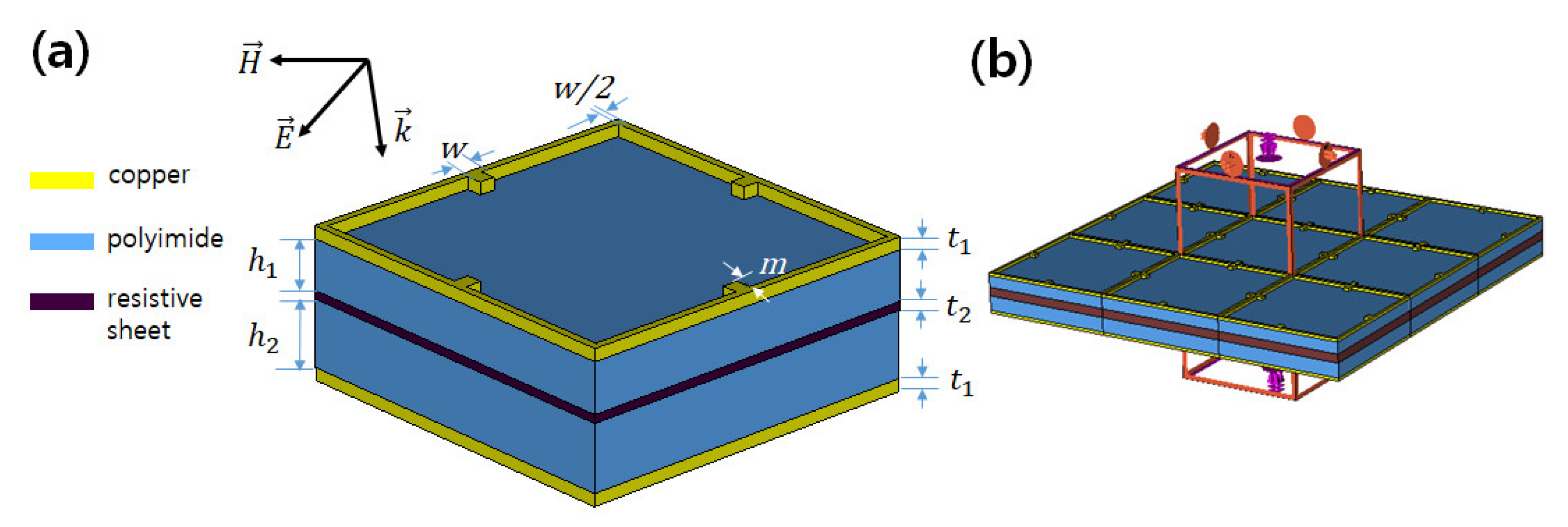
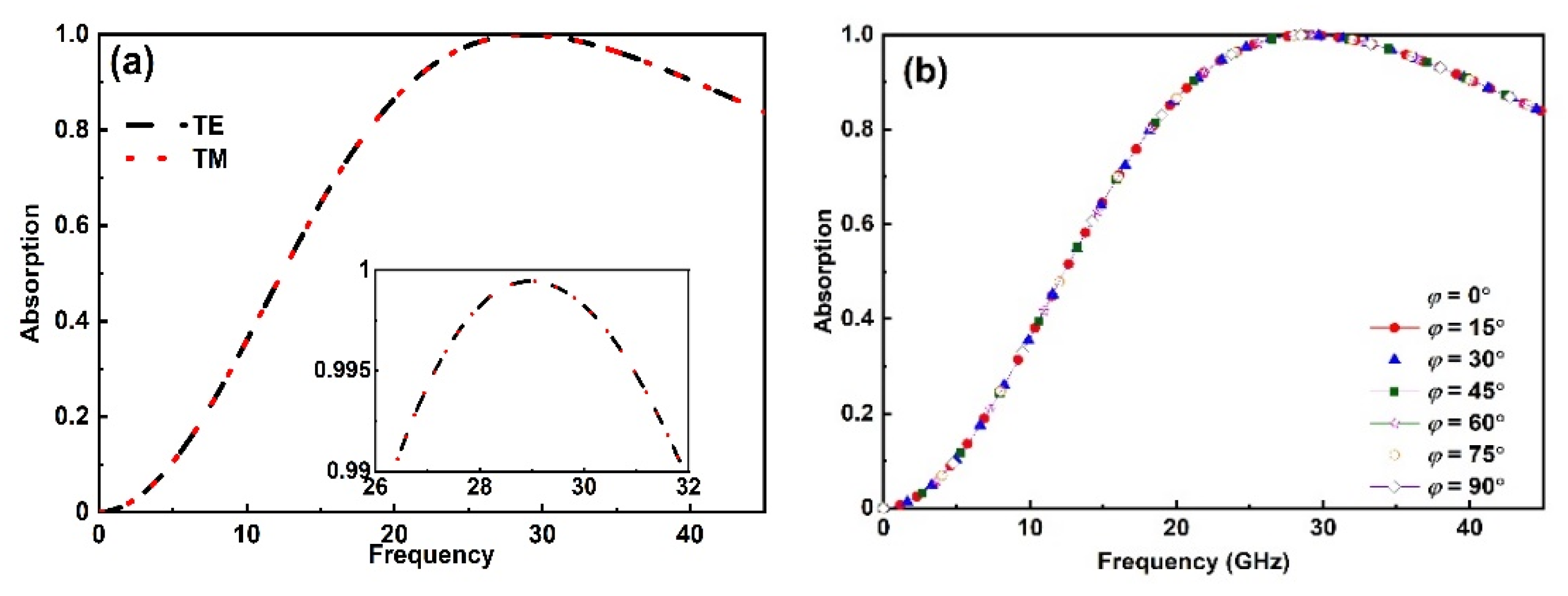
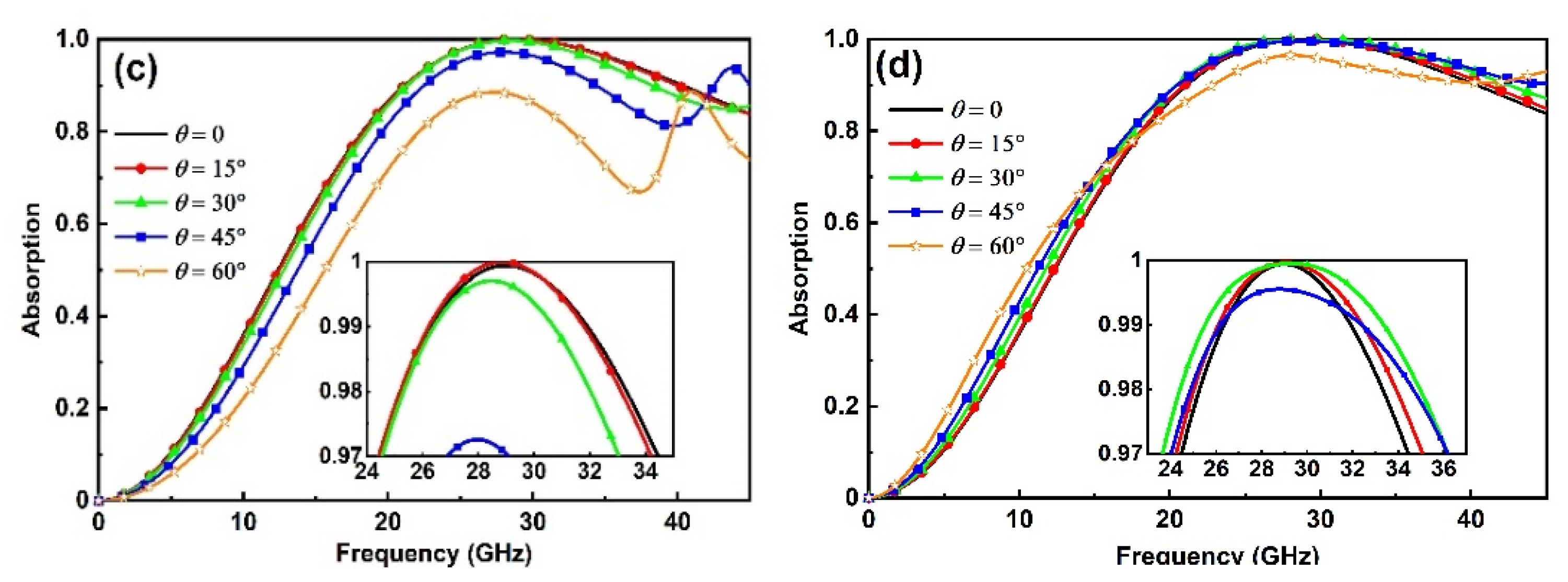
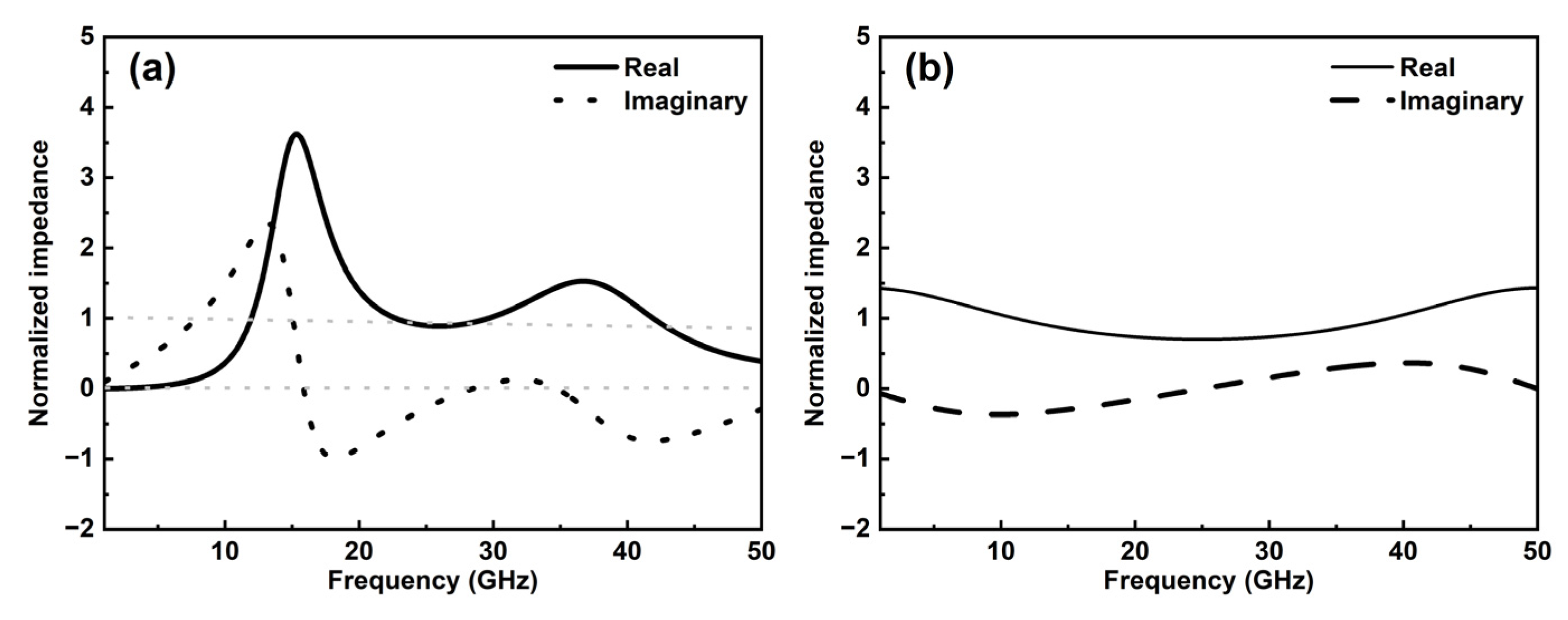
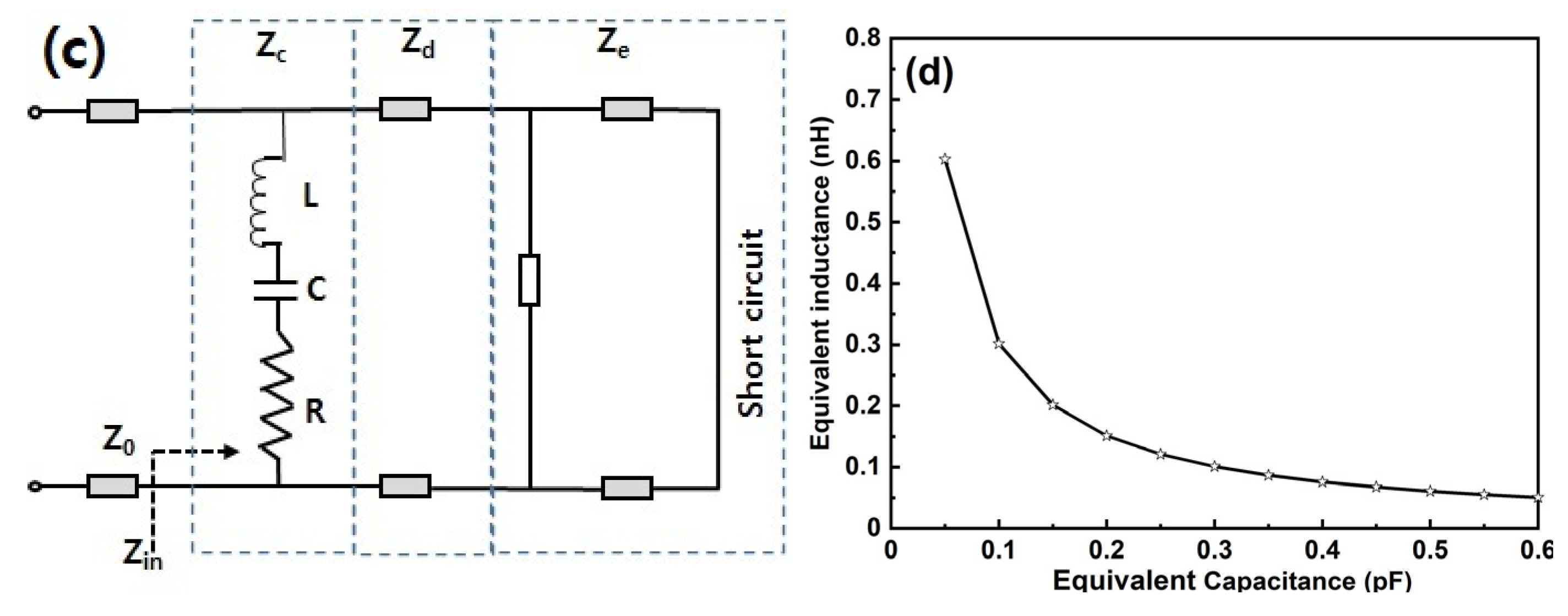
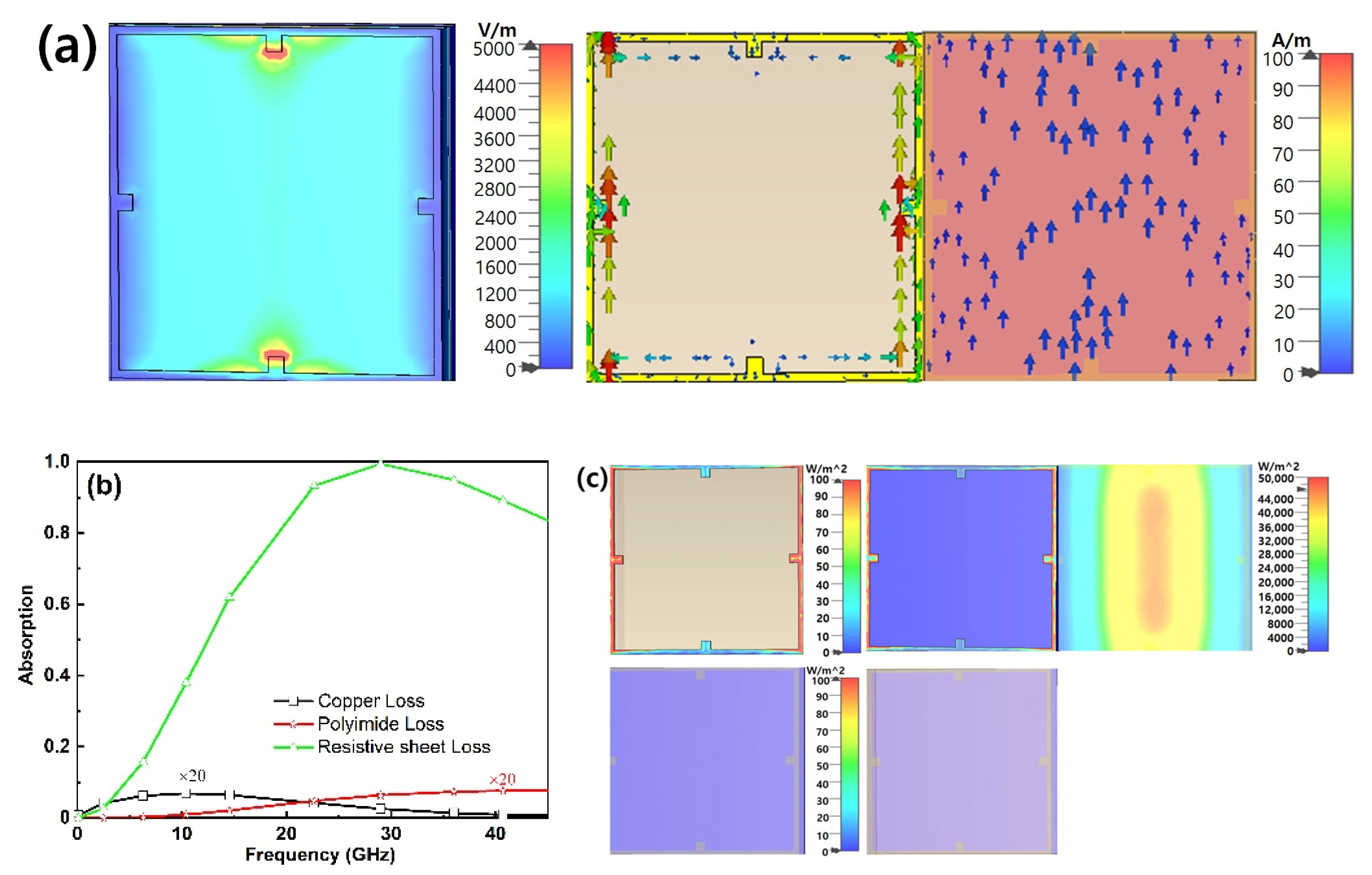
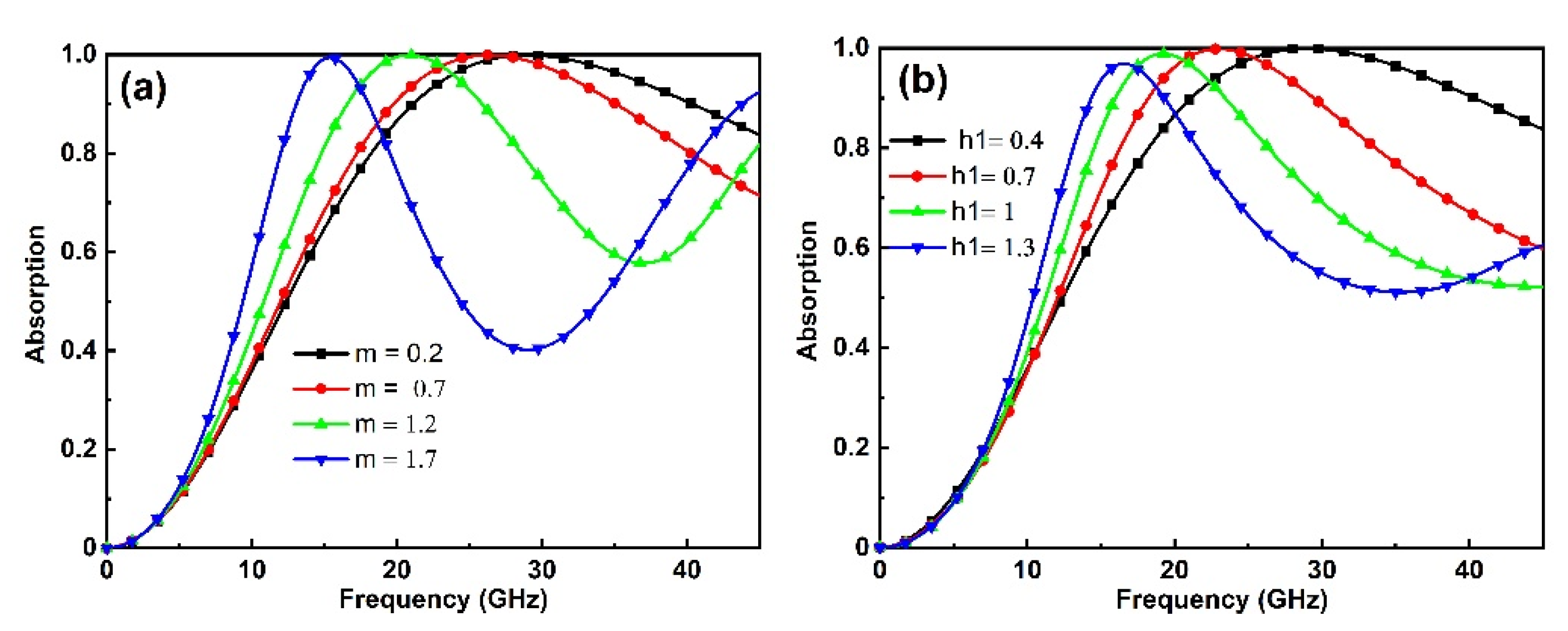


| h1 | h2 | w | t1 | t2 | m |
|---|---|---|---|---|---|
| 0.4 | 0.5 | 0.2 | 0.035 | 0.1 | 0.2 |
| Reference | Year | Flexible | Bandwidth (≥90%) (GHz) | FBW (%) | ERF (GHz) |
|---|---|---|---|---|---|
| [24] | 2017 | No | 9.2–9.3 | 1 | 0 |
| [23] | 2020 | No | 5.12–5.22 | 2 | 5.15–5.17 (0–40°) |
| [44] | 2021 | Yes | 5.61–29.17 | 135 | 0 |
| [47] | 2021 | Yes | 4.47–4.44 | 1.6 | 0 |
| 7.91–7.78 | 1.6 | 0 | |||
| [48] | 2021 | Yes | 8–20 | 85.71 | 0 |
| [49] | 2022 | No | 4.3–24.5 | 140.3 | 13.8–15.77 (0–50°) |
| [37] | 2022 | Yes | 8.5–10.3 | 69 | 10.11–10.2 (0–40°) |
| this work | 2023 | Yes | 21.15–40.35 | 62 | 26.86–29 |
| 61.2–104.7 | 52 | 75.9–80.4 |
Disclaimer/Publisher’s Note: The statements, opinions and data contained in all publications are solely those of the individual author(s) and contributor(s) and not of MDPI and/or the editor(s). MDPI and/or the editor(s) disclaim responsibility for any injury to people or property resulting from any ideas, methods, instructions or products referred to in the content. |
© 2023 by the authors. Licensee MDPI, Basel, Switzerland. This article is an open access article distributed under the terms and conditions of the Creative Commons Attribution (CC BY) license (https://creativecommons.org/licenses/by/4.0/).
Share and Cite
Zheng, H.; Chen, L.; Lee, Y. High-Performance and Flexible Metamaterial Wave Absorbers with Specific Bandwidths for the Microwave Device. Crystals 2023, 13, 868. https://doi.org/10.3390/cryst13060868
Zheng H, Chen L, Lee Y. High-Performance and Flexible Metamaterial Wave Absorbers with Specific Bandwidths for the Microwave Device. Crystals. 2023; 13(6):868. https://doi.org/10.3390/cryst13060868
Chicago/Turabian StyleZheng, Haiyu, Liangyao Chen, and YoungPak Lee. 2023. "High-Performance and Flexible Metamaterial Wave Absorbers with Specific Bandwidths for the Microwave Device" Crystals 13, no. 6: 868. https://doi.org/10.3390/cryst13060868







